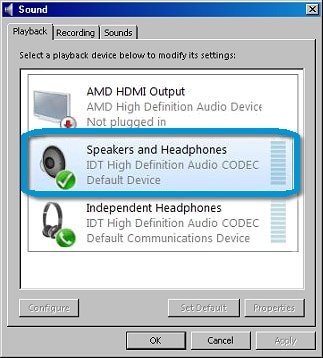Speakers On Monitor Not Working
For external speakers not working in Windows 10, there are several reasons causing this problem. The speakers could be damaged, the sound could be muted, the audio driver could be faulty and so forth. If you encounter this problem, follow tips here to troubleshoot the problem and find the solution that works for you.Firstly, check if the speakers have problemWhen a device is not working, the first thing you should check is if the device itself is working properly. To check if the speakers have problem, try in on another and see if it works. If it works properly, there is no problem with the speakers. If not, you might need to replace it with a new one.Secondly, make sure they are correctly plugged in to the computer (for desktop computers)Many computers have three or more jacks that connect to a sound card or sound processor, including a microphone jack, line-in jack, and line-out jack.Your speakers should be plugged in to the line-out jack.
Best Answer: The speakers on the monitor need to have an audio cable connected to it at one end and the other end plugged into the computer's audio output. Without that cable connection, your speakers won't work. The monitor will have an audio input jack on it somewhere, usually on the under side near the video and power connections. Published: 2017-02-28 In case the Plug and Play function of your Philips speaker does not work on your PC, please follow these simple steps described below. To install any driver, you need to at least have visual on your Windows 10, which means you will need a spare monitor to be able to apply fixes if it’s your primary monitor that is not working after Windows 10 update. If it’s your second monitor not detect, just use your primary monitor to troubleshoot the problem.
If you’re not sure which jack this is, try plugging your speakers or headphone in to each of the jacks to see if any of them produce sound.Thirdly, make sure that your speaker volume isn’t muted or turned down too low.If your speaker volume is muted or too slow, you can’t hear sound from the speakers. You can follow steps below to check and ensure the volume is set correctly.1) On your keyboard, press Win+R (Windows logo key and R key) at the same time to invoke the run box.2) Type control panel and click OK. This is to open Control Panel window.3) In Control Panel, view by Category, click Hardware and Sound.4) Under Sound, click Adjust system volume.5) If the sound is muted, you will a line cross built icon the button (see below screenshot). In that case, click the speaker icon to unmute it. If the sound is already unmuted, move to next step.6) Move the slider up to increase the volume.If the problem still cannot be resolved, try solutions below.
Sound setting issues or driver issues may also cause this problem.Set Speakers as DefaultYour speakers won’t work if it’s not set as default output of sound. To resolve the problem, you can set the speaker as default.Follow these steps:1) Right-click the speaker icon at the bottom right corner of the desktop and click on Playback devices.2) Highlight Speakers or Speakers /Headphones and click Set Default.Note if you don’t see the speakers in the device list, it may be disabled. In this case, right-click on the blank area and select Show disabled devices on the context menu.After it is listed, right-click on the speakers and click Enable.The problem also can be caused by outdated or missing audio drivers.

Sound Coming From Monitor Not Speakers
So try to fix audio drivers. Uninstall the Audio DriverFollow these steps:1) Press Win+R ( Windows logo key and R key) at the same time. A Run dialog box will appear.2) Type devmgmt.msc in the run box and click OK button. This is to open Device Manager Window.3) In Device Manager, expand category “ Sound, video and game controllers“.Under this category, right-click on your sound card device name.
A context menu will pop up. Then select Uninstall.4) You may be required to confirm the uninstallation. Check the box next to “ Delete the driver software for this device” and click OK.5. Reboot your PC and check to see if the problem is resolved. Update the Audio DriverThe steps above may resolve it, but if they don’t, try to update the audio driver. If you’re not confident playing around with drivers manually, you can do it automatically with.Driver Easy will automatically recognize your system and find the correct drivers for it. You don’t need to know exactly what system your computer is running, you don’t need to risk downloading and installing the wrong driver, and you don’t need to worry about making a mistake when installing.You can update your drivers automatically with either the FREE or the Pro version of Driver Easy.
But with the Pro version it takes just 2 clicks (and you get full support and a 30-day money back guarantee):1) and install Driver Easy.2) Run Driver Easy and click Scan Now. Driver Easy will then scan your computer and detect any problem drivers.3) Click the Update button next to a flagged audio driver to automatically download and install the correct version of this driver (you can do this with the FREE version). Or click Update All to automatically download and install the correct version of all the drivers that are missing or out of date on your system (this requires the Pro version – you’ll be prompted to upgrade when you click Update All).To solve your speakers no sound issue in Windows 10, try instructions above.